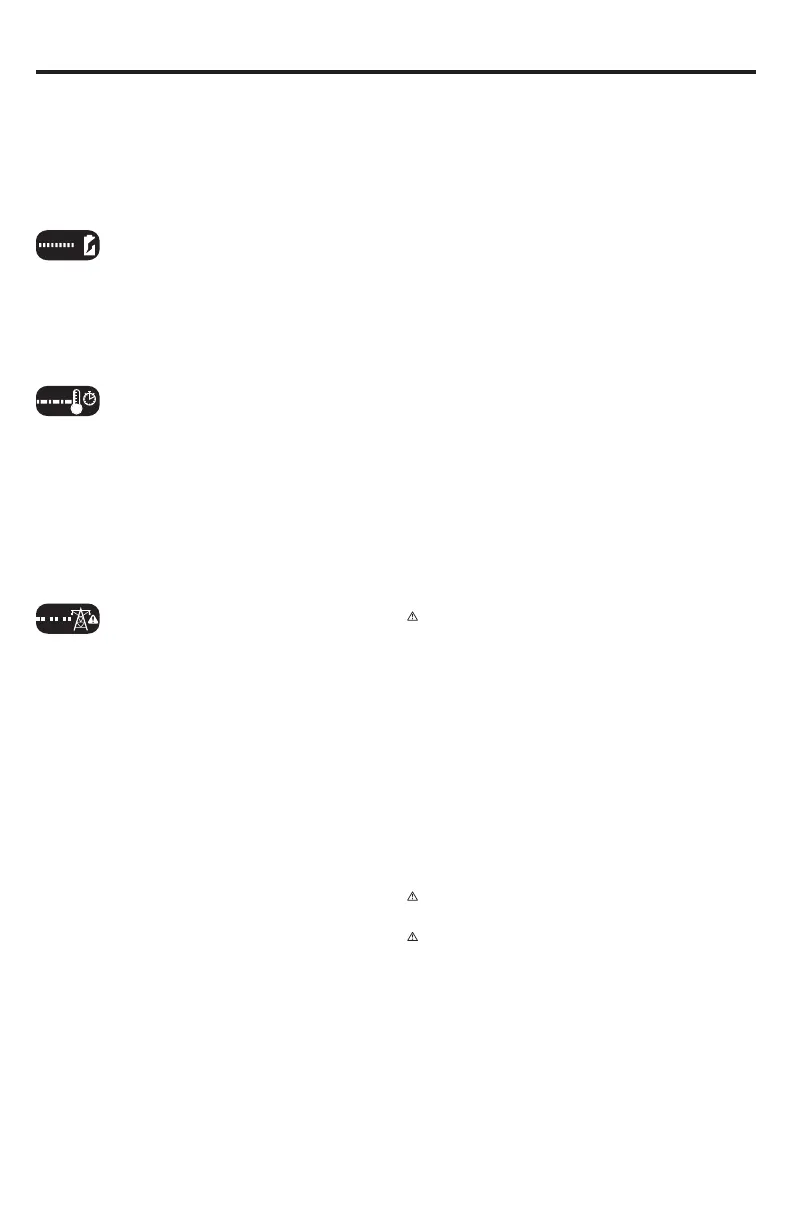ENGLISH • 23
CHARGER DIAGNOSTICS
This charger is designed to detect certain problems that
can arise with the battery packs or the power source.
Problems are indicated by one LED flashing in different
patterns.
Bad battery
The charger can detect a weak or damaged
battery. The LED flashes in the pattern
indicated on the label. If you see this bad
battery blink pattern, do not continue to charge
the battery. Return it to a service center or a
collection site for recycling.
Hot/Cold pack delay
When the charger detects a battery that is
excessively hot or excessively cold, it
automatically starts a Hot/Cold Pack Delay,
suspending charging until the battery has
normalized. After this happens, the charger
automatically switches to the Pack Charging
mode. This feature ensures maximum battery
life. The light flashes in the pattern indicated
on the label.
Problem power line
When the charger is used with some portable
power sources such generators or sources that
convert DC to AC, the charger may temporarily
suspend operation. The LED flashes in the
pattern indicated on the label. This indicates
that the power source is out of limits.
LEAVING THE BATTERY IN THE CHARGER
The charger and battery pack can be left connected with
the LED glowing indefinitely. The charger will keep the
battery pack fresh and fully charged. This charger features
an automatic tune-up mode which equals or balances the
individual cells in the battery pack to allow it to function at
peak capacity. Battery packs should be tuned up weekly or
whenever the battery no longer delivers the same amount
of work. To use the automatic tune-up mode, place the
battery pack in the charger and leave it for at least 8 hours.
IMPORTANT CHARGING NOTES
1. Longest life and best performance can be obtained
if the battery pack is charged when the air temperature
is between 65°F and 75°F (18°C - 24°C). DO NOT
charge the battery pack in an air temperature below
+40°F (+4,5°C), or above +105°F (+40,5°C).
This is important and will prevent serious damage
to the battery pack.
2. The charger and battery pack may become warm
to touch while charging. This is a normal condition,
and does not indicate a problem. To facilitate the
cooling of the battery pack after use, avoid placing
the charger or battery pack in a warm environment
such as in a metal shed, or an uninsulated trailer.
3. If the battery pack does not charge properly:
a. Check current at receptacle by plugging in
a lamp or other appliance
b. Check to see if receptacle is connected to a light
switch which turns power off when you turn out
the lights.
c. Move charger and battery pack to a location where
the surrounding air temperature is approximately
65°F - 75°F (18°C - 24°C).
d. If charging problems persist, take the tool, battery
pack and charger to your local service center.
4. The battery pack should be recharged when it fails
to produce sufficient power on jobs which were easily
done previously.
5. DO NOT CONTINUE to use under these conditions.
Follow the charging procedure.
6. You may also charge a partially used pack whenever
you desire with no adverse affect on the battery pack.
OPERATING INSTRUCTIONS
Installing and removing the battery pack
from the tool
Caution! Make certain the lock-off button is engaged
to prevent switch actuation before removing or installing
battery.
f To install battery pack
Insert battery pack firmly into tool until an audible click
is heard as shown in Fig. B Ensure battery pack is
fully seated and fully latched into position.
f To remove battery pack
Depress the battery release button (7) as shown in
Fig. C and pull battery pack out of tool.
Safety warnings and instructions: Drills
Warning! Before using tool, read all instructions and
cautionary markings on tool.
Warning! Drill may stall (if overloaded or improperly
used) causing a twist. Always expect the stall. Grip the
drill firmly with two hands to control the twisting action and
prevent loss of control which could cause personal injury.
If a stall does occur, release the trigger immediately and
determine the reason for the stall before re-starting.
Trigger switch & forward/reverse button (Fig. D)
f The drill is turned ON and OFF by pulling and
releasing the trigger switch (1) shown in Fig. D. The
farther the trigger is depressed, the higher the speed
of the drill.
f A forward/reverse control button (2) determines the
